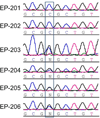SLC25A22 is a novel gene for migrating partial seizures in infancy
- PMID: 24596948
- PMCID: PMC4031329
- DOI: 10.1002/ana.23998
SLC25A22 is a novel gene for migrating partial seizures in infancy
Abstract
Objective: To identify a genetic cause for migrating partial seizures in infancy (MPSI).
Methods: We characterized a consanguineous pedigree with MPSI and obtained DNA from affected and unaffected family members. We analyzed single nucleotide polymorphism 500K data to identify regions with evidence of linkage. We performed whole exome sequencing and analyzed homozygous variants in regions of linkage to identify a candidate gene and performed functional studies of the candidate gene SLC25A22.
Results: In a consanguineous pedigree with 2 individuals with MPSI, we identified 2 regions of linkage, chromosome 4p16.1-p16.3 and chromosome 11p15.4-pter. Using whole exome sequencing, we identified 8 novel homozygous variants in genes in these regions. Only 1 variant, SLC25A22 c.G328C, results in a change of a highly conserved amino acid (p.G110R) and was not present in control samples. SLC25A22 encodes a glutamate transporter with strong expression in the developing brain. We show that the specific G110R mutation, located in a transmembrane domain of the protein, disrupts mitochondrial glutamate transport.
Interpretation: We have shown that MPSI can be inherited and have identified a novel homozygous mutation in SLC25A22 in the affected individuals. Our data strongly suggest that SLC25A22 is responsible for MPSI, a severe condition with few known etiologies. We have demonstrated that a combination of linkage analysis and whole exome sequencing can be used for disease gene discovery. Finally, as SLC25A22 had been implicated in the distinct syndrome of neonatal epilepsy with suppression bursts on electroencephalogram, we have expanded the phenotypic spectrum associated with SLC25A22.
Figures








Comment in
-
Reply: To PMID 24243345.Ann Neurol. 2014 Feb;75(2):326. doi: 10.1002/ana.24055. Epub 2014 Jan 2. Ann Neurol. 2014. PMID: 24242934 No abstract available.
-
Genetic heterogeneity in malignant migrating partial seizures of infancy.Ann Neurol. 2014 Feb;75(2):324-6. doi: 10.1002/ana.24061. Epub 2014 Jan 2. Ann Neurol. 2014. PMID: 24243345 No abstract available.
References
-
- Coppola G, Plouin P, Chiron C, Robain O, Dulac O. Migrating partial seizures in infancy: a malignant disorder with developmental arrest. Epilepsia. 1995 Oct;36(10):1017–1024. - PubMed
-
- Coppola G, Operto FF, Auricchio G, D'Amico A, Fortunato D, Pascotto A. Temporal lobe dual pathology in malignant migrating partial seizures in infancy. Epileptic Disord. 2007 Jun;9(2):145–148. - PubMed
-
- Coppola G. Malignant migrating partial seizures in infancy: an epilepsy syndrome of unknown etiology. Epilepsia. 2009 May;50(Suppl 5):49–51. - PubMed
-
- Coppola G, Veggiotti P, Del Giudice EM, et al. Mutational scanning of potassium, sodium and chloride ion channels in malignant migrating partial seizures in infancy. Brain & development. 2006 Mar;28(2):76–79. - PubMed
Publication types
MeSH terms
Substances
Grants and funding
LinkOut - more resources
Full Text Sources
Other Literature Sources

